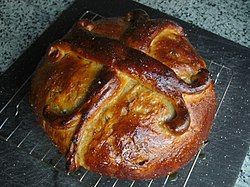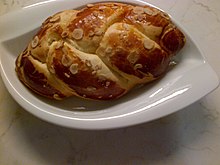 Christopsomo Christmas bread Christopsomo Christmas bread | |
| Alternative names | Katʿnahuncʿ or Bsatir |
|---|---|
| Type | Sweet bread |
| Place of origin | Armenia, Greece |
| Region or state | Balkans, Anatolia, Middle east |
| Variations | Savoury versions |
Tsoureki (Greek: τσουρέκι) also known as šurēk (Hijazi Arabic: شُريك), cöreg, čʿorek, katʿnahuncʿ (Armenian: չէօրէկ, չորեկ, կաթնահունց), çörək (Azerbaijani), çyrek (Albanian), kozunak (Bulgarian: козунак), cozonac (Romanian) or paskalya çöreği (Turkish) is a sweet holiday bread made with flour, milk, butter, eggs, and sugar and commonly seasoned with orange zest, mastic resin, or mahlab. Lampropsomo, a variation of tsoureki commonly called "Greek Easter bread," is made by Greek communities during Easter, not only in Greece, but also in other countries with Greek communities. It is also called Armenian Easter bread and gets eaten during Easter in Armenia and the Armenian diaspora.
Etymology
The Greek word tsoureki is derived from the Turkish word çörek, meaning "round bread" in Old Turkic. Some dictionaries claim that this is derived from the Old Turkish root çevir- 'turn' or 'to make it round'. The ancient Armenian name was "bsatir - պսադիր" ("bsag պսակ" - "crown" and "tir դիր", is the root of "tnel դնել" verb: "to put"). This Armenian name is in allusion to Christ’s crown of thorns.
Greek tradition
There are different variations of the Greek tsoureki holiday breads including a round Christmas loaf with a cross decoration called Christopsomo, a braided Easter bread with whole dyed eggs pressed into the dough called lampropsomo, and a loaf with a coin hidden inside for good luck called vasilopita that is baked for St. Basil's Day (New Year's Day).
Easter bread

Tsoureki is made for Easter in Greece and among the Greek diaspora. It is made from a sweet yeast dough of flour, sugar, eggs, butter and milk, with dyed red Easter eggs pressed into the dough. The dough is brushed with egg wash before baking, and sometimes flavored with mahlep, mastic resin or orange zest. Other flavorings might include almond extract, cinnamon, sultanas or fennel seed.
This bread is sometimes called "Armenian Easter bread". In Armenian, the common name is choreg (չորեկ) or choreg (չէօրէկ), from the Turkish, with the Armenian name gatnahunts (կաթնահունց) being less common. Before baking choreg, the surface is painted with egg yolk, and the heat of the oven browns it until it acquires a reddish-brown tone that represents the blood of Christ. Traditional Armenian choreg omits the dyed Easter eggs, as they are instead used in the Surb Zatik egg fight, another Armenian easter tradition.
Its Turkish name is paskalya çöreği 'Easter çörek'. It does not include whole eggs pressed into the dough as decoration. Some recipes substitute a neutral-flavored oil, such as sunflower oil, and margarine in place of milk and butter. The dough may be seasoned with orange zest, vanilla, mahlep and slivered almonds.
Sometimes tsoureki is used as a gift for special occasion; for instance, it can be given as an Easter gift from children to their godparents.
Christmas bread
Christopsomo (Χριστόψωμο), which translates as "Christ's bread", is a traditional Greek holiday bread that is sometimes decorated with whole walnuts, sesame seeds and slivered almonds. Also called Christmas fruit bread, the tsoureki dough may include a combination of raisins, dried apricots, dried figs, orange zest, cinnamon, allspice, cloves, cardamom, Mastic (plant resin) and mahleb. (Some recipes suggest marinating the raisins and dried figs overnight in wines like retsina or mavrodaphne). Some of the dough is set aside for the loaf's cross-shaped decoration.
The bread may be glazed with a syrup made from honey, orange juice, and slivered almonds.
See also
- Brioche
- Cardamom bread
- Challah
- Cozonac, the Romanian and Bulgarian variant
- Kulich (bread)
- List of foods with religious symbolism
- Nut roll
- Pulla
- Vánočka
- Zopf
References
- Roufs, Timothy G.; Roufs, Kathleen Smyth (2014-07-29). Sweet Treats around the World: An Encyclopedia of Food and Culture: An Encyclopedia of Food and Culture. ABC-CLIO. ISBN 978-1-61069-221-2.
- ^ Davidson, Alan (1981-01-01). National & Regional Styles of Cookery: Proceedings : Oxford Symposium 1981. Oxford Symposium. ISBN 978-0-907325-07-9. Archived from the original on 2016-05-14. Retrieved 2018-07-22.
- "çörek". Nişanyan Sözlük (in Turkish). Retrieved 2024-06-06.
- Chrysopoulos, Philip (3 May 2024). "Tsoureki: The Traditional Sweet Bread of Greek Easter". The Greek Reporter. Retrieved 6 June 2024.
- "çörek". Etymological Dictionary of Contemporary Turkish. Archived from the original on 2017-12-01. Retrieved 2017-05-12.
- Dwight, Harry Griswold (1915). Constantinople, Old and New. Longmans, Green. p. 331. Retrieved 2017-05-12.
- "Chefs prepare Easter feasts with special dishes, breads". 12 April 2017. Archived from the original on 2018-01-02.
- The Oxford Companion to Sugar and Sweets. Oxford University Press. 2015-04-01. ISBN 978-0-19-931362-4.
- Kochilas, Diane (2013-05-02). "Tsoureki (Greek Easter Bread)". Diane Kochilas. Retrieved 2022-04-18.
- "Greek Easter Bread". Food Network. Archived from the original on 2018-03-23. Retrieved 2018-07-22.
- "Tsoureki (Greek Easter Bread)". Martha Stewart. 2013-02-28. Archived from the original on 2017-06-21. Retrieved 2018-07-22.
- "Tsoureki bread (Greek Easter bread)". BBC Food. Retrieved 2018-07-22.
- "Paul Hollywood's Tsoureki- Greek Easter Bread Recipe". PBS Food. 2018-03-12. Archived from the original on 2018-07-23. Retrieved 2018-07-22.
- Roufs, Timothy G.; Roufs, Kathleen Smyth (2014-07-29). Sweet Treats around the World: An Encyclopedia of Food and Culture: An Encyclopedia of Food and Culture. ABC-CLIO. ISBN 978-1-61069-221-2.
- "Armenian Easter - Surb Zatik". Armenian-History.com. Retrieved 2024-11-25.
- "Chefs prepare Easter feasts with special dishes, breads". 12 April 2017. Archived from the original on 2018-01-02. Retrieved 2018-07-22.
- "Paskalya Çöreği tarifi… En lezzetli gerçek Paskalya Çöreği nasıl yapılır?". April 2018. Archived from the original on 2018-04-01. Retrieved 2018-07-22.
- Soysal, Sahrap. "Mahlepli paskalya çöreği". Archived from the original on 2017-05-07. Retrieved 2018-07-22.
- "Paskalya çöreği tarifi - Hamurişi Haberleri". Archived from the original on 2016-08-14. Retrieved 2018-07-22.
- Arda'nın Mutfağıundefined (Director). Paskalya Çöreği - Arda'nın Mutfağı. Event occurs at 321 seconds. Archived from the original on 2018-07-23. Retrieved 2018-07-22.
- Nursel'in Evi. Paskalya Çöreği Tarifi. Archived from the original on 2018-07-23. Retrieved 2018-07-22.
- ^ Kochilas, Diane (1993-03-15). The Food and Wine of Greece: More Than 250 Classic and Modern Dishes from the Mainland and Islands. Macmillan. ISBN 978-0-312-08783-8.
- Guinn, Jeff (2012). Santa's North Pole Cookbook: Classic Christmas Recipes from Saint Nicholas Himself. Jeremy P. Tarcher/Penguin. ISBN 978-0-399-16064-6.
- Hensperger, Beth (2000-04-30). Bread Lover's Bread Machine Cookbook: A Master Baker's 300 Favorite Recipes for Perfect-Every-Time Bread-From Every Kind of Machine. Harvard Common Press. ISBN 978-1-55832-156-4. Archived from the original on 2018-07-23. Retrieved 2018-07-22.
- ^ Hoffman, Susanna (2004). The Olive and the Caper: Adventures in Greek Cooking. Workman Publishing. p. 142. ISBN 978-0-7611-3468-8.
- Pasteleria Artesana. Programa N° 53: 1 de diciembre 2012: Algunas Historias... Christopsomo. Retrieved 2018-07-22.
| Armenian cuisine | |||||||||||||
|---|---|---|---|---|---|---|---|---|---|---|---|---|---|
| Հայկական խոհանոց | |||||||||||||
| Ingredients |
| ||||||||||||
| Breads | |||||||||||||
| Soups | |||||||||||||
| Appetizers and salads | |||||||||||||
| Main entrées | |||||||||||||
| Grilled meats | |||||||||||||
| Beverages |
| ||||||||||||
| Desserts | |||||||||||||
| Instruments | |||||||||||||